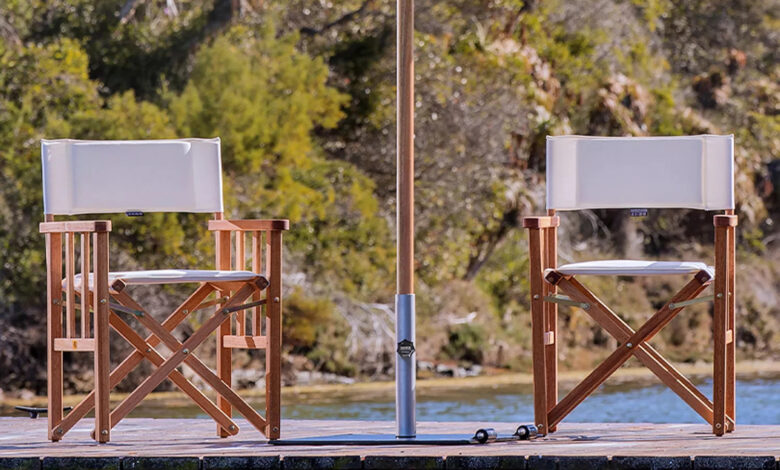Directors Chair: A Comprehensive Guide to Versatile Seating

In the realm of furniture, where comfort meets style, the directors chair stands as an iconic symbol of authority and sophistication. Its distinctive design and historical significance make it a coveted piece, not just for directors on film sets, but also for those seeking a touch of classic charm in their homes or offices. In this comprehensive guide, we delve into the world of directors chairs, exploring their origins, evolution, and the reasons behind their enduring popularity.
What is a Directors Chair?
At its core, a directors chair is a portable, folding chair that features a simple yet ingenious design. It typically consists of a wooden frame with X-shaped legs, supporting a fabric seat and backrest. The defining feature of these chairs is the absence of a solid backrest, allowing for easy customization and personalization through the addition of canvas or fabric inserts.
History of Directors Chairs
The history of directors chairs traces back to the early 20th century, with their origin shrouded in the world of Hollywood filmmaking. Initially designed for directors on film sets, these chairs quickly became synonymous with the glamour of the movie industry. The lightweight and foldable nature of the directors chair made it a practical choice for on-the-go professionals, allowing them to easily move and set up their workspace.
Evolution of Design
Over the years, the design of directors chairs has evolved while maintaining its core elements. Traditional directors chairs were constructed using wooden frames, often made from beech or oak, providing a sturdy yet elegant foundation. Today, modern versions may incorporate materials like aluminum or steel for enhanced durability and reduced weight.
The seat and backrest are typically made from canvas, providing a comfortable yet breathable seating experience. However, contemporary designs may offer a variety of materials, including polyester or even leather, catering to diverse preferences and styles.
- Materials Beyond Wood: While traditional directors chairs featured ooden frames, contemporary designs have embraced materials like aluminum and steel. This evolution enhances durability without compromising on the chair’s elegant aesthetic.
- Diverse Seating Options: In addition to classic canvas, modern directors chairs may incorporate a range of materials such as polyester and leather for the seat and backrest. This diversification allows users to choose chairs that align with their preferences and interior styles.
- Innovative Color Options: Unlike the traditional black or natural wood finishes, directors chairs now come in a spectrum of colors. This innovation in color options allows individuals to match or contrast their chairs with existing decor, adding a personalized touch.
Personalizatzon and Customization
One of the most appealing aspects of directors chairs is their customizable nature. The absence of a solid backrest creates a canvas for personal expression. Directors and individuals alike can personalize their chairs by adding custom fabric inserts, showcasing logos, names, or artistic designs. This feature extends beyond the realm of filmmaking, making directors chairs a unique and personalized addition to any space.
Versatility in Use
Directors chairs have transcended their initial purpose on film sets, finding a place in various settings. They are no longer confined to the studio; these chairs have become a staple in homes, offices, and outdoor spaces. The versatility of directors chairs lies in their ability to seamlessly blend into different environments while adding a touch of classic elegance.
Directors chairs, once confined to the realm of film sets and studios, have transcended their original purpose, becoming a symbol of timeless elegance and practicality. In this exploration of the multifaceted use of directors chairs, we uncover the diverse scenarios where these iconic seats seamlessly blend functionality with style.
Film and Entertainment Industry
The primary and traditional use of directors chairs remains in the film and entertainment industry. Positioned behind the scenes, directors rely on these chairs as their command center, overseeing the creative process and making crucial decisions.
Home Décor and Interior Design
Directors chairs have seamlessly transitioned from movie sets to living rooms, dining areas, and even bedrooms. Their classic design and customizable features make them a chic and timeless addition to home décor, adding a touch of sophistication to any space.
The foldable and portable nature of directors chairs makes them ideal for compact living spaces. Residents in apartments or small homes appreciate their ability to be easily stored or moved around, providing functional seating without compromising on style.
Outdoor Adventures and Recreation
Campsite Comfort: Outdoor enthusiasts have embraced directors chairs as essential gear for camping trips. The lightweight and foldable design make them convenient to pack, and their sturdy construction ensures a comfortable seating option around the campfire.
Event Seating and Hospitality
Directors chairs are a popular choice for event planners and organizers seeking temporary seating solutions. Their elegant appearance and ease of customization make them suitable for conferences, weddings, and other gatherings.
From hotel lobbies to upscale restaurants, directors chairs contribute to a sophisticated atmosphere. Their adaptability to different settings, coupled with the ability to incorporate branding, makes them a preferred choice in the hospitality industry.
Artist Studios and Workspaces
Artists and designers appreciate the practicality and aesthetic appeal of directors chairs in their studios. The ability to personalize the fabric inserts allows for a touch of individuality in these creative spaces.
Directors chairs have found their way into modern office environments, providing a flexible and stylish seating option for workspaces. Their portability allows for quick rearrangements, fostering collaboration and creativity.
Functionality and Portability:
Apart from their aesthetic appeal, directors chairs are prized for their functionality and portability. The folding design allows for easy storage, making them an ideal choice for those with limited space. The lightweight nature of these chairs makes them effortless to carry, enabling users to take them on outdoor adventures, camping trips, or use them as temporary seating for events.
- Ergonomic Improvements: Beyond the iconic design, contemporary directors chairs often feature ergonomic enhancements. These improvements include curved backrests and contoured seats for added comfort during prolonged use.
- Integrated Features: Some directors chairs go beyond the basics, integrating features like built-in cup holders or side tables. This functional enhancement makes them not only stylish but also practical for various settings, from film sets to outdoor events.
- Weather-Resistant Options: To cater to outdoor enthusiasts, manufacturers now offer weather-resistant directors chairs. These versions are designed to withstand exposure to the elements, making them perfect for outdoor activities like camping or beach outings.
Iconic Symbolism
The directors chair has become more than just a piece of furniture; it embodies a sense of authority and accomplishment. The use of these chairs on film sets has elevated their status, associating them with the creative and decision-making processes behind the scenes. As such, owning a directors chair is often seen as a symbol of prestige and sophistication.
Contemporary Designs and Innovations
While the traditional directors chair remains a timeless classic, contemporary designers have embraced the challenge of reinventing this iconic piece. Innovations include ergonomic improvements for enhanced comfort, additional features such as built-in cup holders or side tables, and a broader range of materials and color options to suit diverse tastes.
Maintenance and Care
To ensure the longevity of a directors chair, proper maintenance is essential. Cleaning the fabric regularly, avoiding prolonged exposure to harsh weather conditions, and storing the chair in a cool, dry place when not in use will help preserve its quality. Wooden frames may benefit from occasional polishing to maintain their natural luster.
Conclusion
In conclusion, the directors chair is far more than a mere piece of furniture; it is a symbol of elegance, versatility, and creative authority. From its humble beginnings on film sets to its current status as a sought-after home or office accessory, the directors chair has truly stood the test of time. Its timeless design, coupled with the ability to personalize and customize, ensures that it remains a cherished item for those seeking a touch of classic charm in their surroundings. Whether on a movie set, in a cozy living room, or under the open sky, the directors chair continues to captivate with its blend of form and function, making it an enduring icon in the world of furniture.
FAQs
What is the origin of directors chairs, and why are they associated with the film industry?
Directors chairs originated in the early 20th century and became synonymous with the film industry due to their practicality. Lightweight and foldable, they provided on-the-go professionals, particularly directors, with a portable and comfortable seating solution on film sets.
How have directors chairs evolved over the years in terms of design and materials?
Traditionally made with wooden frames, directors chairs now incorporate materials like aluminum and steel. The seat and backrest, initially crafted from canvas, now offer a variety of options, including polyester and leather. These changes enhance durability, reduce weight, and provide a wider range of customization.
What makes directors chairs a versatile choice for home décor?
Directors chairs seamlessly transition from movie sets to homes, offering a classic design and customizable features. Their foldable and portable nature makes them ideal for compact living spaces, providing functional seating without compromising on style.
How can directors chairs be personalized, and is this feature limited to filmmakers?
Directors chairs are highly customizable, with the absence of a solid backrest allowing for personal expression. Anyone, not just filmmakers, can personalize their chairs by adding custom fabric inserts, logos, names, or artistic designs. Making them a unique and personalized addition to any space.
In what settings, besides film and home, are directors chairs commonly used?
Directors chairs have found versatile applications in outdoor adventures, such as camping trips, and in event planning for temporary seating solutions. They are also popular in hospitality settings like hotels and restaurants, contributing to a sophisticated atmosphere.
Are contemporary directors chairs designed with additional features beyond the classic foldable design?
Yes, contemporary directors chairs often come with ergonomic improvements for enhanced comfort. Some models also feature built-in cup holders or side tables, catering to a variety of settings, from film sets to outdoor events. Manufacturers even offer weather-resistant options for outdoor enthusiasts.




